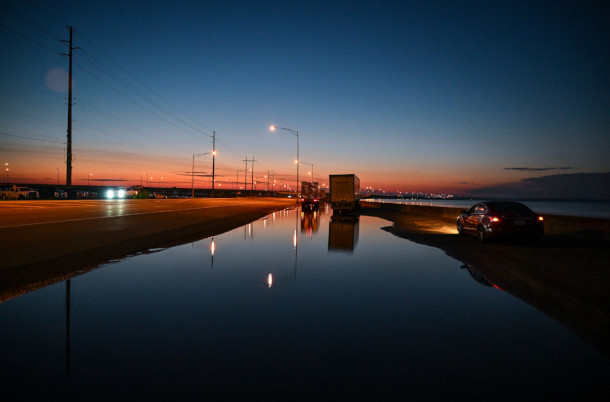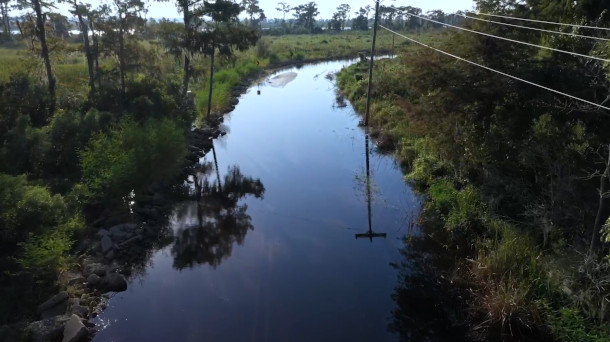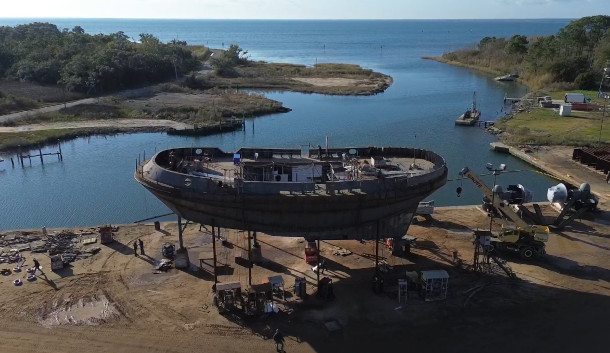The Drowning South
Air Date: Week of May 24, 2024

The Southeast United States has seen roughly equivalent sea level rise since 2010 as it saw in the 50 years before that. In this photo from September 2023 water pools on the Causeway in Mobile, Alabama. (Photo: Ricky Carioti/The Washington Post)
Sea levels are rising everywhere due to climate change but not equally, and a recent Washington Post series called “The Drowning South” documents how the US southeast is experiencing an especially rapid rise. Journalist Chris Mooney joins Host Paloma Beltran to talk about how communities near Mobile, Alabama and St. Tammany Parish, Louisiana are being affected.
Transcript
O’NEILL: It’s Living on Earth, I’m Aynsley O’Neill.
BELTRAN: And I’m Paloma Beltran.
Sea levels are rising everywhere due to climate change, but not equally. The U.S. Southeast is experiencing an especially rapid rise. A recent Washington Post series called “The Drowning South” found that since 2010, seas have risen as much as they had over the previous half century. Some communities are even deeper underwater because of sinking land and extreme rain events. Washington Post journalist Chris Mooney was part of a team that put together the Drowning South series, and he’s here now. Chris, welcome to Living on Earth!
MOONEY: Thank you for having me.
BELTRAN: So you call this series “The Drowning South.” What did your analysis find?
MOONEY: What we did was we looked at federal sea level data and tide gauges all around this region. It turns out there's been a very rapid recent acceleration in the rise of the sea. And if you just take it from 2010 to the present, all along the Gulf Coast and up the part of the Southeast to around the Carolinas, then you're getting around six inches of change in just a little over 10, 15 years. So that's much faster than what you got in prior decades.
BELTRAN: And I understand you also looked into New Orleans, Louisiana. How did the scenario of rising seas play out there?
MOONEY: That's a little tricky. And this is where I'm from. New Orleans has built comprehensive flood protections, a really impressive system of protection from the Corps of Engineers. So they are actually well protected against most hurricanes now. What we did was we looked at Louisiana more broadly. And the protections that New Orleans has are not replicated. So if you just drive across the causeway, across Lake Pontchartrain, you know, around 20 miles to the north you’re in St. Tammany Parish. Huge growth, a lot of people going there, huge flooding problems. Lake Pontchartrain has risen at least six inches or more, because it's connected to the Gulf of Mexico. And we went and on sunny days saw the lake just swallow up a coastal road, just to give one example. So not everywhere is as well protected as New Orleans. And the impacts are throughout Louisiana, really. Another one of the biggest impacts of sea level rise is the loss of the coast, because the coast is a vast area of wetlands that protect New Orleans and other cities. And what has already been documented is that this recent fast burst of sea level rise is too fast for Louisiana's coastal wetlands to handle. Wetlands grow, to some extent, to keep up with the ocean, but not when it's rising this quickly. So researchers at Tulane University, right in New Orleans, have found that many of them are now in a "state of drowning," which is to say that they're spending too much time below the level of the water.
BELTRAN: And what about Miami and the state of Florida?
MOONEY: I mean, it's all in this region where the change has been very rapid. And so they're all going to be seeing a number of the same kinds of thing—not everybody has Louisiana's wetlands. But in general, you're going to be seeing coastal erosion. You're going to be seeing something called high tide flooding, which is that, you know, there's a tidal cycle, and increasingly at the high period of the tide, it's just a lot higher than it used to be. So things that used to be dry, always, now are starting to go under. Those could be roads; those could be people’s docks. It really depends on the location, but it's often going to be various types of infrastructure. What we also really wanted to focus on was something that doesn't get enough attention, and that is that sea level rise doesn't just act on its own. It acts in combination with other things. The number one most damaging thing that it acts alongside, in this region, we found, is rainfall. So if you have rain in a coastal city, or just a coastal area, it needs to get to the ocean to drain. Means it needs to go downhill. It needs to go downhill either in a pipe out of a city or in a river. Right? They're both sloped. Well, the sea level is now higher at the end of either of those. And so sometimes the pipes are underwater at the other end. Or the mouth of the river is maybe a—could be a foot higher. So the water doesn't get out nearly as rapidly. And so it backs up, and you get all this inland flooding, including in these events that scientists term compound events, right? So you can have extreme rain and, at the same time, you can have a quite high sea, and the water will not be able to get out, and it'll just flood inland. And so you get flooding in sunny-day conditions when the tide just comes up. But then you get potentially more extreme things when the tide is high and it's raining.
BELTRAN: And you've reported on this extensively. What are some stories that people have shared with you?

Madisonville, Louisiana’s Main Street flooded in September 2023. The water came from the nearby Tchefuncte River during high tide. (Photo: Ricky Carioti/The Washington Post)
MOONEY: You hear many, many stories of just kind of like what I told you— “my dock didn't used to go under, now it goes under. Now I have to raise it.” But we told the story in Alabama, south of Mobile, of an extreme flood that occurred, which was just in June of last year, where we were able to have an expert run a model to document that the water was deeper and the flood lasted longer, because the sea level at the end of a river called Fowl River was in a high tide flood state of the sort that we've been talking about when, it's hard to know the number, but 10-ish inches of rain fell. So it was a very extreme event. And you had water rescues occurring. We spoke with the local fire chief who was sort of having to deal with this. And he sort of drove around in the morning, because it already had been raining, looking at all the ditches, seeing how high the water in the ditches was getting, knowing that when it got onto the roads, he would have to call out everybody he could, start shutting them down. It did keep raining. And then pretty soon, they were having to bring people back to the firehouse. Then it kept raining, and there were places they couldn't get to, where people were stranded. And they had to call the City of Mobile to come on down, because this local fire department didn't have a boat. So they needed different fire department to come down and conduct water rescues.
BELTRAN: And some of your reporting has shown that people of color and lower socioeconomic groups often bear the brunt of this heavy flooding. How has that played out in Mobile, Alabama?

Tug boat construction in Coden Bayou in Bayou La Batre, Alabama. (Photo: Jahi Chikwendiu/The Washington Post)
MOONEY: Mobile has just done a new report under their resilience officer, Casi Callaway, who spoke with us for this project. And in their own city report, they acknowledged that the historic legacy of redlining has created a situation in which people of color in the city of Mobile are more likely to experience flooding. So Mobile is basically aware of, and has researched for itself, sort of the growing literature that shows that some of the historic housing policies that were highly unequal and still have a legacy today are now contributing unequally to climate change risks. And flooding is one of those. And in fact, in many cases, communities that were once redlined tend to be lower lying, that’s one of the reasons. But also because it's sort of a cycle that fed upon itself, might have received lower investment in terms of drainage infrastructure, which you need to get water out, and also might have more pavement, fewer trees. And if there's more pavement, then that means water also doesn't drain into the ground, so it can rush around and flood people, so. I mean and I think we saw in extreme events like Katrina and other hurricanes, how flooding impacts are not equal.
BELTRAN: What are some of the roadblocks that communities across the South are experiencing when it comes to adapting to increasing sea level rise and increased flooding?
1. For the last year, I’ve been buried in a project that merges together data journalism with storytelling from the region I grew up in – the U.S. South, and especially the Gulf Coast. Today, that project started to publish.
— Chris Mooney (@chriscmooney) April 29, 2024
MOONEY: It's really a money issue. Because, you know, you essentially have roads and drainage systems and sewer systems and many other kinds of things that are all just lower, right? And they're lower than they used to be relative to the height of the water. And frequently these, these cities are old. They were built a long time ago, hundreds of years ago—Mobile, Pensacola, New Orleans, right? They've got long histories. So when they were established, they were established against a sea level that's really different. I mean, there's been a fast recent change, but there's also been a several-hundred-year change, and the trend has been up the whole time. So it's just very hard and expensive to adapt.
BELTRAN: What are some of the solutions that local authorities are applying? And how much is that going to cost?

Reporter Chris Mooney covers energy and environment for the Washington Post. He's worked with a team of writers to cover the intensifying sea level rise in the Southern United States with his series, "The Drowning South." (Photo: Courtesy of the Washington Post)
MOONEY: Well, that's the real thing. And, you know, if you're willing to spend enough, you can raise anything that you want. Or, in the case of Galveston, pumps that cost many tens of millions of dollars are also able to overcome what we discussed, which is gravity, right? You need—normally, gravity is taking the water out, but if the water at the receiving body, the ocean, is too high, gravity starts to fail for you. But a pump, you know, will give you force, again, behind the flow of that water. So you can do this, and New Orleans has pumps, because it's, it's so low. So you can spend money, but it's a lot of money, right? Because you have to think about all the kinds of things—a lot of roads are increasingly too low. So they will go under at high tides. You have this sort of happening throughout the region’s—you can elevate a road. But every time, you know, you're talking in the millions of dollars.
BELTRAN: Chris Mooney is an environmental reporter for the Washington Post. Chris, thank you so much for joining us.
MOONEY: Thank you for having me.
Links
Maps showing sea level rise from the National Oceanic and Atmospheric Administration
Lean more about the impacts from sea level rise on home values in Alabama and elsewhere
Living on Earth wants to hear from you!
Living on Earth
62 Calef Highway, Suite 212
Lee, NH 03861
Telephone: 617-287-4121
E-mail: comments@loe.org
Newsletter [Click here]
Donate to Living on Earth!
Living on Earth is an independent media program and relies entirely on contributions from listeners and institutions supporting public service. Please donate now to preserve an independent environmental voice.
NewsletterLiving on Earth offers a weekly delivery of the show's rundown to your mailbox. Sign up for our newsletter today!
 Sailors For The Sea: Be the change you want to sea.
Sailors For The Sea: Be the change you want to sea.
 The Grantham Foundation for the Protection of the Environment: Committed to protecting and improving the health of the global environment.
The Grantham Foundation for the Protection of the Environment: Committed to protecting and improving the health of the global environment.
 Contribute to Living on Earth and receive, as our gift to you, an archival print of one of Mark Seth Lender's extraordinary wildlife photographs. Follow the link to see Mark's current collection of photographs.
Contribute to Living on Earth and receive, as our gift to you, an archival print of one of Mark Seth Lender's extraordinary wildlife photographs. Follow the link to see Mark's current collection of photographs.
 Buy a signed copy of Mark Seth Lender's book Smeagull the Seagull & support Living on Earth
Buy a signed copy of Mark Seth Lender's book Smeagull the Seagull & support Living on Earth

